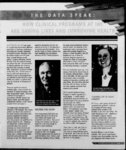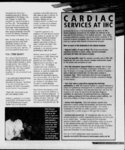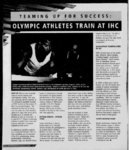| OCR Text |
Show hemoglobin Ale blood essential in effective management of the disease has now increased to nearly 90, compared to a national average of less than 40. The percentage of patients with unacceptably high blood sugar levels decreased from 34 to 24. These achievements were recently recognized when IHC received The National Exemplary Practice Award for Diabetes Care. test-consi- dered With the help of his family, Tim is managing his blood sugar levels effectively, thanks in part to services of the outreach clinic. "The nurses are really nice," said Tim. "I don't even mind the blood tests." FULL-TER- M BABIES Staci Johnson had already been through one problem pregnancy, and she wasn't looking forward to going through another. Her condition required more than four months of bed rest and "rest" was a concept foreign to her daughter, who was accustomed to an active mom. four-year-o- ld "I was scared about losing the baby developing inside me, or of delivering him too soon," said Staci. "I was also concerned about my daughter, who didn't stop needing me just because I was pregnant. "That's why I was so glad to get help from Katrina Jensen." Katrina is a perinatal care manager based at IHC's LDS Hospital and part of the IHC Beginnings Program. Katrina's job is to help k expectant mothers like Stad carry their babies as near to full term as possible. Like the diabetes care managers, Katrina and her colleagues function as health care coaches, reaching out to patients and helping them with whatever issues happen to arise. "I especially appredated my telephone link with Katrina, because I was confined to my bed and I live some distance from the hospital," said Stad. "She checked on me regularly and talked me through several episodes that might have otherwise sent me running needlessly to the hospital, putting my developing baby at risk." Katrina's service is one of several care initiatives of IHC's Women and Newborns Clinical Program. The program has made numerous improvements to care since it was created in 1997. For example, successes have been achieved in reducing the incidence of premature deliveries, in caring for infants who are bom prematurely, and in improving the way certain medications are prescribed. As is often the case, gains in clinical quality have also resulted in cost savings, with the costs of normal deliveries actually dropping by 3.5 last year. Stad delivered her baby boy at full term an outcome she attributes in large part to Katrina's assistance. "It was so important having Katrina just a phone call away," Stad said. "IHC is an organization that really cares and goes the extra mile for you." at-ris- A R D 11 AC SERVICES AT IHC Cardiovascular is one of the first and most successful of IHC's clinical programs, renowned for the number and diversity of its cases and for the excellence of its medical outcomes. Any cardiac procedure performed anywhere around the world is available at IHC. Expertise is shared throughout IHC, even at smaller rural hospitals, network of exceptional strength. creating a system-wid- e Here are some of the hallmarks of this clinical program: Highest number of cases in Utah. This is important because experience correlates to patient safety: the more procedures performed, the better the clinical outcomes. Very low mortality rates. For example, mortality rates at IHC's LDS Hospital are 24 lower than national averages would predict, based on the number and seriousness of cases. Very fast emergency response times. For example, time in administering thrombolytic medications is less than 30 minutes, on average, throughout IHC's network of hospitals even at small rural hospitals like IHC's Bear River Hospital in Tremonton, Utah. This is much faster than the Utah average of 50 minutes a difference in speed that saves lives and prevents damage to heart muscle. door-to-dr- clot-busti- Very high rates of prescribing appropriate discharge medications. In 1999, IHC hospitals instituted a program designed to ensure that patients are discharged with the medications appropriate for their cardiac conditions, thus extending best heart care from the hospital to the home. By improving the way these drugs are prescribed, we significantly decreased mortality and readmission rates, saving an estimated 450 lives, reducing patient suffering, and eliminating millions of dollars in patient hospital costs. System-wid- e computer systems allow expertise. High-tec- h physicians to consult quickly and accurately, simultaneously viewing diagnostic images. For example, a patient data and cardiologist in Cedar City can review a patient's moving-pictur- e angiogram with a cardiac surgeon in Salt Lake City or Ogden. high-quali- ty procedures. IHC hospitals are often the only Utah hospitals approved to perform experimental procedures and participate in new clinical trials. Examples include the Left Ventricular Assistance Device (LVAD), a partial artificial heart which can be used to help patients survive when the muscular tissue of the heart is Leading-edg- rfMutue Katrina Jens? e weakened by disease. LDS Hospital was one of only about 20 facilities in the U.S. participating in a study of the use of the LVAD as a permanent alternative to heart transplants. For a list of other leading-edg- e cardiac procedures, visit www.ihc.comxpihcldsresearchEpecialfopicscardio.xmL xszimmgrmrag |























